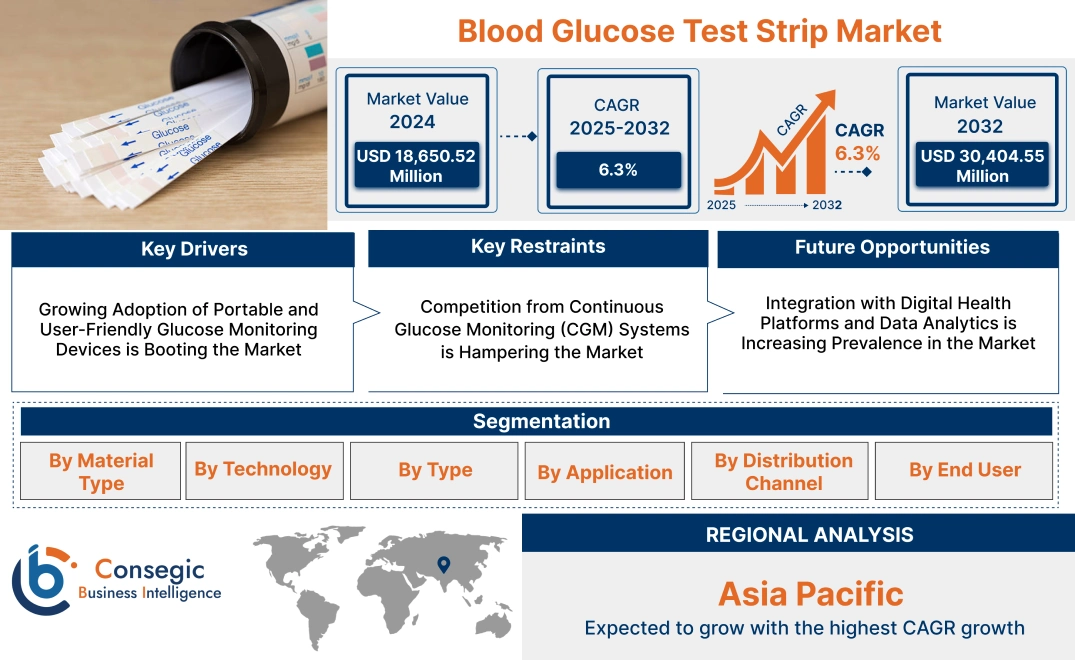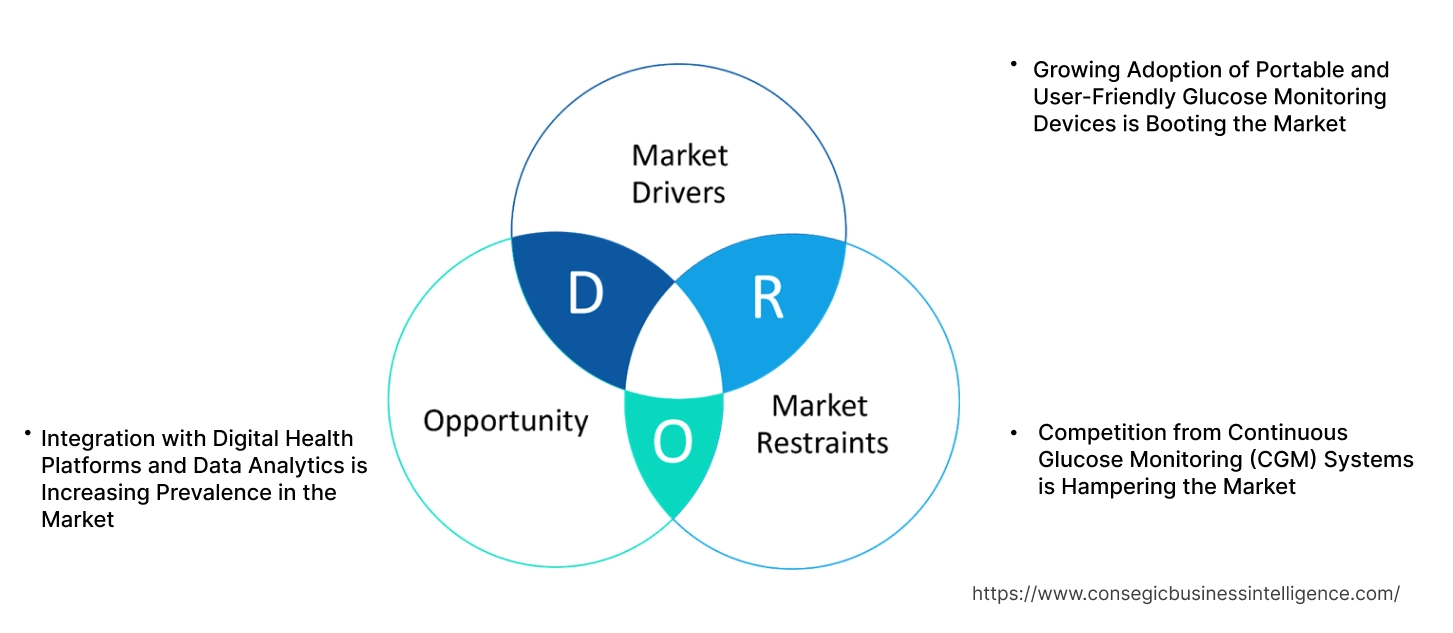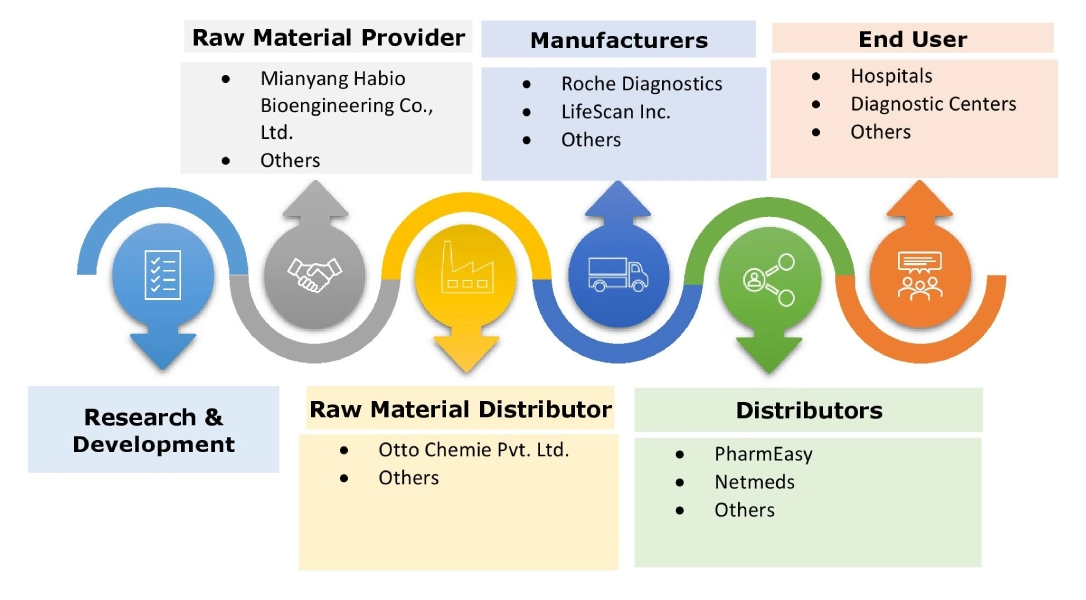Blood Glucose Test Strip Market Size:
Blood Glucose Test Strip Market size is estimated to reach over USD 30,404.55 Million by 2032 from a value of USD 18,650.52 Million in 2024 and is projected to grow by USD 19,493.18 Million in 2025, growing at a CAGR of 6.3% from 2025 to 2032.
Blood Glucose Test Strip Market Scope & Overview:
Blood glucose test strips refer to small, disposable plastic strips that are used in combination with a glucose meter for measuring the concentration of glucose in a blood sample. It is an essential tool for individuals managing diabetes to monitor their blood sugar levels and manage their condition effectively. Moreover, glucose test strips enable regular monitoring of blood sugar levels, which further helps in identifying patterns, such as consistently high or low blood sugar levels, thereby facilitating timely intervention and preventing long-term complications.
Blood Glucose Test Strip Market Dynamics - (DRO) :
Key Drivers:
Rising prevalence of diabetes is propelling the blood glucose test strip market growth
The rising prevalence of diabetes is a significant factor driving the market. Diabetes often requires constant monitoring of blood glucose levels for managing the condition effectively. This can be achieved through the utilization of blood glucose test strips. Moreover, changes in lifestyle, such as increased rates of obesity and physical inactivity, often contribute to the rise in type 2 diabetes, which further increases the demand for testing of blood sugar levels. As more individuals are diagnosed with diabetes, the demand for blood glucose monitoring and glucose test strips is also increasing significantly, in turn driving the market.
- For instance, according to the International Diabetes Federation, approximately 589 million adults (ranging between 20-79 years) worldwide are living with diabetes as of 2024, while the total number of individuals living with diabetes is expected to increase up to 853 million by 2050.
Therefore, the rising prevalence of diabetes is proliferating the blood glucose test strip market size.
Key Restraints:
Availability of alternative blood sugar monitoring solution, such as continuous glucose monitor (CGM), is restraining the blood glucose test strip market
The availability of alternative blood sugar monitoring solution, such as continuous glucose monitor (CGM), is among the primary factors restricting the market growth. A continuous glucose monitor refers to a device that tracks blood glucose levels continuously throughout the day and night, providing real-time glucose data and patterns.
Unlike traditional glucose test strips that require finger pricks for frequent measurements, CGMs offer a more comprehensive view of glucose levels. Moreover, CGMs use a tiny sensor inserted under the skin (typically on the arm or abdomen) to measure glucose levels in interstitial fluid. This facilitates improved diabetes management by identifying patterns, predicting potential issues such as hypoglycemia or hyperglycemia, and enabling timely adjustments to treatment plans. Additionally, the utilization of continuous glucose monitors also eliminates the need for frequent finger-prick blood glucose checks, which can be inconvenient and uncomfortable. Consequently, the above factors are hindering the blood glucose test strip market expansion.
Future Opportunities :
Integration with digital health solutions is expected to drive the blood glucose test strip market opportunities
The integration of glucose test strips with digital health solutions can significantly enhance the functionality of diabetes management and improves patient outcomes. Moreover, digital health solutions, involving mobile apps and cloud-based platforms, enable users to track, store, and analyze blood glucose readings from glucose test strips. This provides a complete overview of glucose levels, helping individuals and healthcare providers make more informed decisions regarding patients’ treatment and lifestyle, which are further expected to provide lucrative opportunities for market growth.
- For instance, a research study published in the National Library of Medicine demonstrated a new test strip technology platform for self-monitoring of blood glucose levels. A new blood glucose monitoring system platform was developed based on the new CONTOUR NEXT (CN) test strip. This blood glucose monitoring system platform utilizes a proprietary electron mediator and algorithm for minimizing errors at several steps in the testing process, in turn reducing outliers and substantially improving the accuracy as compared to traditional blood glucose meter systems.
Thus, according to the analysis, the aforementioned factors are expected to boost the blood glucose test strip market opportunities during the forecast period.
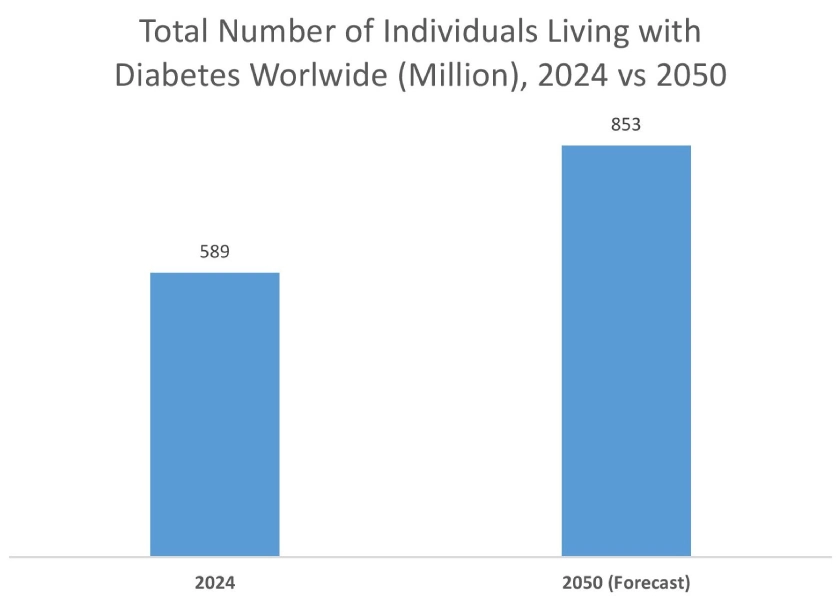
Blood Glucose Test Strip Market Segmental Analysis :
By Material Type:
Based on material type, the market is segmented into thick film electrochemical films, thin film electrochemical films, and optical strips.
Trends in the material type:
- Increasing trend in utilization of thick film electrochemical films in glucose test strips, due to its increased stability, lower production costs, resistance to environmental factors, and reliable performance.
- Rising adoption of thin film electrochemical films in glucose test strips, attributed to its several benefits, such as enhanced sensitivity, improved selectivity, and increased stability in glucose detection.
The thick film electrochemical films segment accounted for the largest revenue in the total blood glucose test strip market share in 2024.
- Thick film electrochemical films are primarily used in glucose test strips to detect glucose levels in a small blood sample, providing a quantitative measurement that is displayed on a glucose meter.
- Moreover, these films are usually deposited on a substrate and contain enzymes and mediators that react with glucose, which generates an electrical current that is proportional to the glucose concentration.
- Additionally, the utilization of these films in blood glucose test strips offers a range of benefits, including increased stability, lower production costs, resistance to environmental factors, and reliable performance.
- According to the analysis, the aforementioned benefits of thick film electrochemical films are further increasing its utilization in glucose test strips, in turn propelling the glucose test strip industry growth.
The thin film electrochemical films segment is anticipated to register the fastest CAGR during the forecast period.
- Thin film electrochemical films play a vital role in facilitating the functionality of glucose test strips by allowing the electrochemical detection of glucose in a blood sample.
- These thin films are often composed of materials such as metal oxides or conducting polymers. They are deposited on electrodes within the test strip and interact with glucose, which produces an electrical signal that is then measured and translated into a glucose reading.
- Additionally, these thin films provide several benefits, including enhanced sensitivity, improved selectivity, and increased stability in glucose detection, which are key determinants for driving its adoption in glucose test strips.
- Hence, the aforementioned factors are anticipated to drive the industry during the forecast period.
By Technology:
Based on technology, the market is segmented into glucose oxidase-based test strips and glucose dehydrogenase-based test strips.
Trends in the technology:
- There is a rising trend towards utilization of glucose oxidase-based test strips in home glucose monitoring systems, due to their specificity for glucose, ease of use, and relatively lower costs, which is driving the market.
- Increasing trend in adoption of glucose dehydrogenase-based test strips, due to its high accuracy and lower susceptibility to interference from other substances in the blood.
The glucose oxidase-based test strips segment accounted for the largest revenue in the overall blood glucose test strip market share in 2024.
- Glucose oxidase-based test strips refer to disposable plastic strips that contain glucose oxidase, an enzyme that reacts with glucose in a blood sample.
- This reaction produces a measurable signal, typically a change in electrical current or color, which is then used by a blood glucose meter to determine the blood glucose level.
- Moreover, glucose oxidase-based test strips are commonly used in home glucose monitoring systems, due to their specificity for glucose, ease of use, and relatively lower cost.
- Consequently, the aforementioned factors are driving the blood glucose test strip market trends.
The glucose dehydrogenase-based test strips segment is anticipated to register the fastest CAGR during the forecast period.
- Glucose dehydrogenase-based test strips utilize the enzyme glucose dehydrogenase for catalyzing the oxidation of glucose in a blood sample.
- This reaction produces a measurable signal, often an electrical current, that is proportional to the glucose concentration, in turn allowing blood glucose monitoring.
- Similarly, glucose dehydrogenase-based test strips are often used in self-monitoring of blood glucose and play a vital role in managing diabetes.
- Additionally, glucose dehydrogenase-based test strips offer significant benefits, including high accuracy and reduced susceptibility to interference from other substances in the blood, among others.
- Thus, the above factors are anticipated to boost the blood glucose test strip market growth during the forecast period.
By Application:
Based on application, the market is segmented into type 1 diabetes, type 2 diabetes, and gestational diabetes.
Trends in the application:
- Factors including an increasing elderly population, decreasing levels of physical activity, and increasing incidence of obesity are driving the prevalence of type 2 diabetes.
- Increasing cases of gestational diabetes, driven by factors such as pre-existing health conditions, hormonal changes, and lifestyle choices, are further projected to drive the adoption of glucose test strips.
The type 2 diabetes segment accounted for the largest revenue share of 71.30% in the overall market in 2024, and it is anticipated to register a substantial CAGR during the forecast period.
- Type 2 diabetes is a chronic condition that is characterized by high blood sugar levels, which is mainly caused due to two factors: the body not producing enough insulin or the cells not responding properly to insulin (insulin resistance). This leads to a buildup of glucose in the bloodstream, which can cause various health problems over time.
- Moreover, glucose test strips are essential for individuals with type 2 diabetes to monitor their blood sugar levels regularly.
- These strips, used in combination with a glucometer, provide a way to measure glucose in a blood sample obtained through a finger prick. This enables individuals with type 2 diabetes to track their glucose levels and helps them manage their condition and make informed decisions regarding diet, exercise, and medication.
- For instance, according to the International Diabetes Federation, more than 90% of individuals with diabetes have type 2 diabetes, which is primarily driven by demographic, environmental, socio-economic, and genetic factors, among others.
- Consequently, the prevalence of substantial number of type 2 diabetes is increasing the adoption of glucose test strips, in turn driving the market.
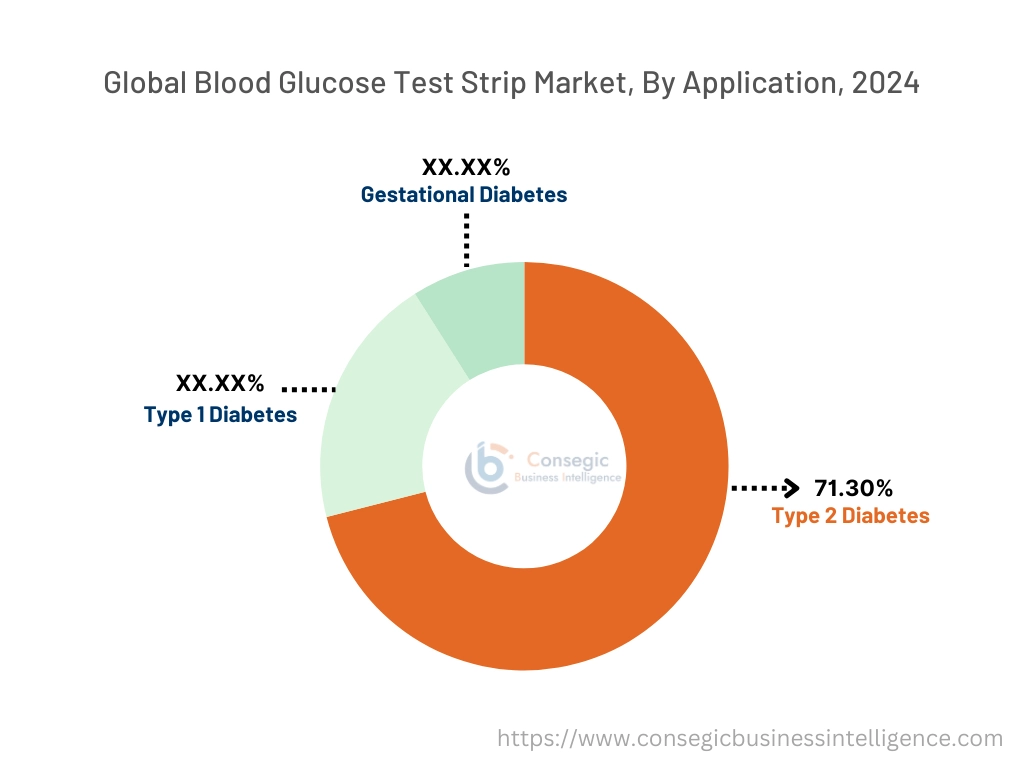
By Distribution Channel:
Based on the distribution channel, the market is segmented into hospital pharmacies, retail pharmacies, and online pharmacies.
Trends in the distribution channel:
- Factors including higher credibility, strong customer base, and ease of customization as per the target market are major factors propelling the retail pharmacies segment development.
- Factors including competitive pricing, increased convenience of online shopping, wider product selection, along with reliable shipping & return policies are among the key aspects driving the online pharmacies
The retail pharmacies segment accounted for the largest revenue share in the total market in 2024.
- A retail pharmacy offers prescription medications and sells over-the-counter drugs and other health-related products directly to the public.
- Moreover, glucose test strips are readily available for distribution at retail pharmacies, which typically offer a variety of glucose test strips from multiple brands to fulfill different needs.
- For instance, Apollo Pharmacy is a retail pharmacy chain in India that offers a wide range of glucose test strips for distribution through its various pharmacy outlets spread across the country.
- According to the analysis, the increasing availability of glucose test strips in retail pharmacies is driving the blood glucose test strip market size.
The online pharmacies segment is anticipated to register the fastest CAGR during the forecast period.
- An online pharmacy typically operates through the internet, allowing customers to purchase medications online and have them delivered.
- Online pharmacies typically offer both prescription and over-the-counter drugs, as well as other health-related products such as glucose test strips.
- Moreover, online pharmacies offer various benefits, including increased convenience, cost savings, wider product selection, and faster access to medications and other health-related products, which are key determinants for driving the distribution of glucose test strips from online pharmacies.
- Thus, the rising availability of glucose test strips in online pharmacies is anticipated to boost the segment growth during the forecast period.
By End-Use:
Based on end-use, the market is segmented into hospitals, homecare settings, diagnostic centers, and others.
Trends in the end-use:
- Increasing emphasis on patient-centric care and the ongoing transition to managing chronic conditions in home-based settings are driving the market.
- Rising collaboration between diagnostic centers and manufacturers for delivering high-quality glucose monitoring solutions is anticipated to further drive the market.
The homecare settings segment accounted for the largest revenue in the overall market in 2024.
- Homecare settings are the primary drivers of the market, largely driven by the increasing adoption of self-monitoring devices for managing diabetes at home.
- Advantages, including increased convenience and cost-effectiveness of monitoring glucose levels at home, are further driving the market.
- Additionally, increasing awareness regarding regular glucose monitoring and technological advancements in home-use glucometers are further driving the market.
- Thus, the above factors are propelling the blood glucose test strip market.
The diagnostic centers segment is anticipated to register the fastest CAGR during the forecast period.
- Diagnostic centers are crucial for the diagnosis and ongoing monitoring of diabetes, providing essential professional glucose testing services.
- Moreover, the growing prevalence of diabetes, coupled with an increased emphasis on precise diagnosis, has significantly propelled the demand for glucose test strips.
- Additionally, increasing investments in advanced diagnostic technologies and development of diagnostic networks are further propelling the market.
- Thus, the aforementioned factors are expected to drive the market during the forecast period.
Regional Analysis:
The regions covered are North America, Europe, Asia Pacific, Middle East and Africa, and Latin America.
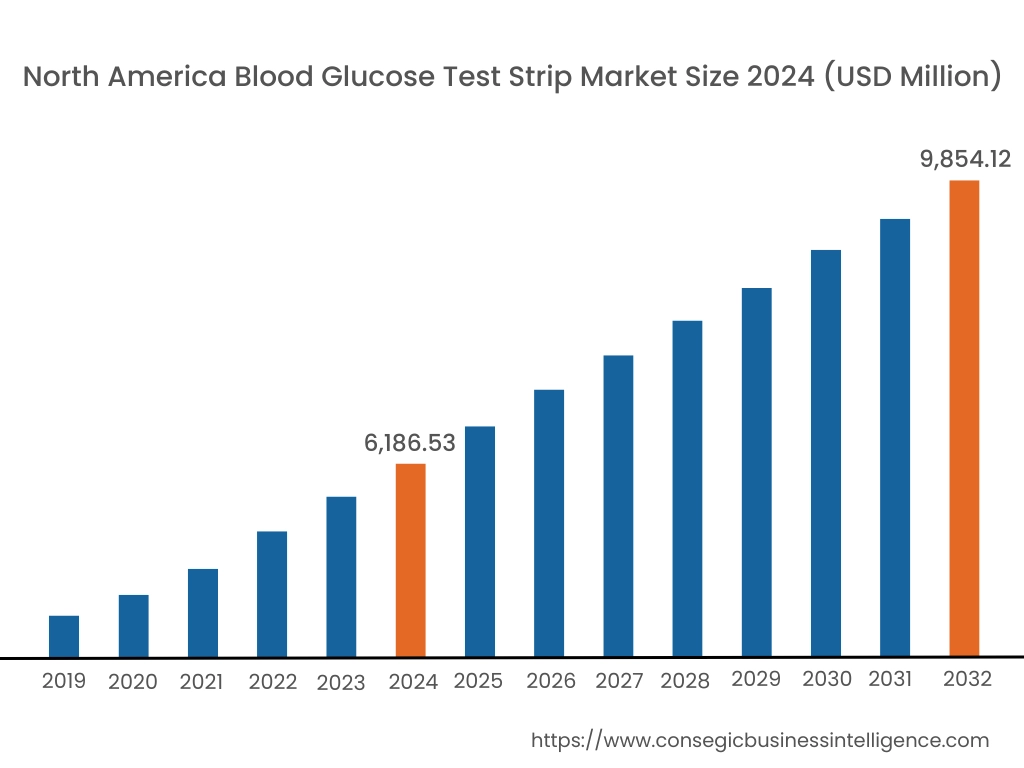
In 2024, North America was valued at USD 6,186.53 Million and it is expected to reach USD 9,854.12 Million in 2032. In North America, the U.S. accounted for the highest share of 73.40% during the base year 2024. In North America, the growth of blood glucose test strip industry is mainly driven by the rising prevalence of diabetes and obesity along with increasing awareness and emphasis on self-monitoring for diabetes management. Similarly, the rising technological advancements associated with blood sugar monitoring solutions are further contributing to the blood glucose test strip market demand.
- For instance, according to the U.S Centers for Disease Control and Prevention, in 2021, an estimated 38.4 million individuals in the U.S had diabetes, representing 11.6% of the total population. The above factors are expected to boost the blood glucose test strip market trends in North America during the forecast period.
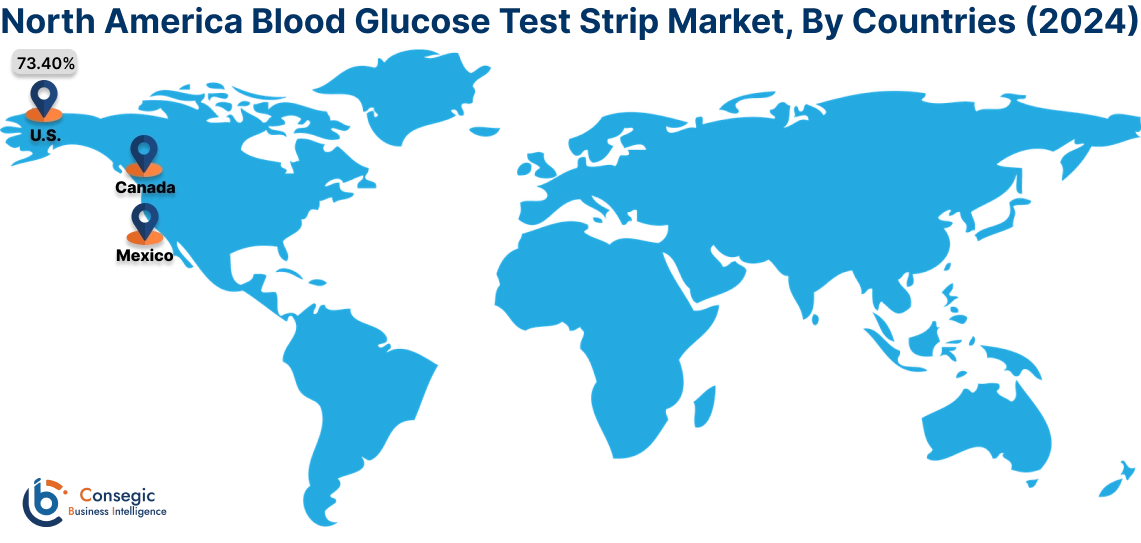
In Asia Pacific, the market is experiencing the fastest growth with a CAGR of 6.7% over the forecast period. As per the blood glucose test strip market analysis, the adoption of glucose test strips in the Asia-Pacific region is primarily driven by the increasing prevalence of diabetes, particularly Type 2 diabetes, caused by factors such as urbanization, changing lifestyles, and rising obesity rates. Additionally, increasing awareness of self-monitoring solutions and improving healthcare infrastructure and services are further driving the market in the region.
- For instance, according to the International Diabetes Federation, the number of adults (20–79 years) with diabetes in India reached up to 89.8 million in 2024. Thus, the above factors are accelerating the blood glucose test strip market expansion in the Asia-Pacific region.
Meanwhile, according to the regional analysis, factors including prevalence of aging population, strong emphasis on preventive healthcare, and favorable reimbursement policies are propelling the blood glucose test strip market demand in Europe. In addition, according to the blood glucose test strip market analysis, the market demand in Latin America, Middle East, and African regions is expected to rise at a significant rate due to factors such as increasing prevalence of diabetes and growing awareness of diabetes management solutions among others.
Top Key Players and Market Share Insights:
The global blood glucose test strip market is highly competitive with major players providing products to the national and international markets. Key players are adopting several strategies in research and development (R&D), product innovation, and end-user launches to hold a strong position in the blood glucose test strip market. Key players in the blood glucose test strip industry include-
- Roche Diagnostics (Switzerland)
- LifeScan Inc. (United States)
- AgaMatrix Inc. (United States)
- Medtronic plc (Ireland)
- Prodigy Diabetes Care LLC (United States)
- Ascensia Diabetes Care (Switzerland)
- Abbott (United States)
- Dexcom Inc. (United States)
- Braun Melsungen AG (Germany)
- Trividia Health Inc. (United States)
Blood Glucose Test Strip Market Report Insights :
| Report Attributes | Report Details |
| Study Timeline | 2019-2032 |
| Market Size in 2032 | USD 30,404.55 Million |
| CAGR (2025-2032) | 6.3% |
| By Material Type |
|
| By Technology |
|
| By Application |
|
| By Distribution Channel |
|
| By End-Use |
|
| By Region |
|
| Key Players |
|
| North America | U.S. Canada Mexico |
| Europe | U.K. Germany France Spain Italy Russia Benelux Rest of Europe |
| APAC | China South Korea Japan India Australia ASEAN Rest of Asia-Pacific |
| Middle East and Africa | GCC Turkey South Africa Rest of MEA |
| LATAM | Brazil Argentina Chile Rest of LATAM |
| Report Coverage |
|
Key Questions Answered in the Report
How big is the blood glucose test strip market? +
The blood glucose test strip market was valued at USD 18,650.52 Million in 2024 and is projected to grow to USD 30,404.55 Million by 2032.
Which is the fastest-growing region in the blood glucose test strip market? +
Asia-Pacific is the region experiencing the most rapid growth in the blood glucose test strip market.
What specific segmentation details are covered in the blood glucose test strip report? +
The blood glucose test strip report includes specific segmentation details for material type, technology, application, distribution channel, end-use, and region.
Who are the major players in the blood glucose test strip market? +
The key participants in the blood glucose test strip market are Roche Diagnostics (Switzerland), LifeScan Inc. (United States), Ascensia Diabetes Care (Switzerland), Abbott (United States), Dexcom Inc. (United States), B. Braun Melsungen AG (Germany), Trividia Health Inc. (United States), AgaMatrix Inc. (United States), Medtronic plc (Ireland), Prodigy Diabetes Care LLC (United States), and others.
Which material type is expected to grow the fastest? +
Thin film electrochemical films are anticipated to grow at the fastest CAGR, driven by their precision, compact design, and compatibility with advanced glucose monitoring devices.
